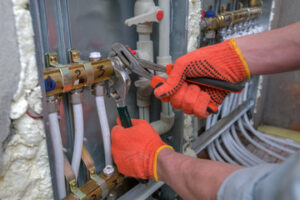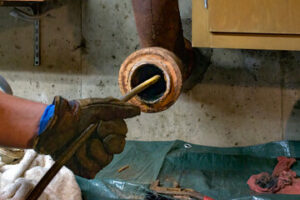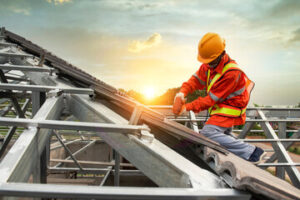Perth Insulation is a crucial component of your home, blocking heat loss and keeping rooms warmer in the winter. It also helps reduce condensation that can lead to mold growth and other health complications.

It’s easy to overlook your insulation, but a good R-Value will drastically cut down your heating and cooling bills. Read on to learn more about what types of insulation are available, including rolled fiberglass and spray foam.
Blown-in insulation is a loose-fill option that comes in various materials. These include cellulose, fiberglass, natural wool, and rockwool. Each offers its own unique set of advantages and considerations. For example, cellulose insulation (often made from recycled newspaper) can be treated with fire retardants and insect repellents for added protection. However, it may absorb moisture, which can cause it to lose its R-Value over time. Fiberglass, on the other hand, is a popular choice for its thermal efficiency and low cost. It also has a high R-Value, and it is moisture resistant.
One of the key benefits of blown-in insulation is that it can be applied to existing walls, as opposed to other types of insulating material which require the demolition of drywall to access wall cavities. This allows homeowners and business owners to easily improve the R-Value of their homes or office spaces without the hassle and expense of tearing down existing walls.
The installation process for blown-in insulation is relatively quick and simple. Professionals use a specialized machine to blow the insulating material into the desired cavity, utilizing a long hose. This method works well for attics and crawl spaces, as well as other areas of the home or building with tight space restrictions. The fluffy consistency of the blown-in material also allows it to fill crevices and nooks that are difficult to reach with traditional batt or roll insulation.
Once the insulating material is blown into the desired space, it expands to fill the area, creating a seamless barrier that prevents heat loss and gain and reduces drafts. Blown-in insulation can also help to lower energy costs, as the insulating material can keep the indoor temperature more stable throughout the year and reduce the need for excessive air conditioning or heating.
Because blown-in insulation is made up of recycled and/or biodegradable materials, it is a great choice for environmentally conscious individuals. Likewise, blown-in insulation is less likely to contribute to respiratory problems than other options. However, it is important to note that blown-in insulation can still be affected by moisture, which can lead to mold growth. This can be prevented by ensuring that proper ventilation is available in the space where the blown-in insulation has been installed.
Foam Insulation
Foam insulation is a common type of home insulation that can be made from several different materials. These materials vary in their density and effectiveness. For example, a higher density foam board typically has a greater R-Value than a lower density foam board. R-Value is a measure of a material’s ability to prevent heat loss or gain. Foam insulation is an effective way to stop air leaks, maintain an indoor temperature, and save energy.
Spray foam insulation is a dense, pollution-free insulator that can be applied with a handheld or pressurized sprayer. It can be installed in walls, floors, attics, roofs, and other places where gaps, holes, and leaks exist. Unlike other types of insulation, which are manufactured in sheets, foam is sprayed and then hardens into an airtight chemical bond. Spray foam also has the added benefit of being a fire-resistant product.
There are two types of spray foam insulation: open-cell and closed-cell. Open-cell spray foam is permeable to moisture and is generally less expensive than closed-cell foam. However, open-cell foam can trap moisture, causing mold and mildew growth. This can lead to wood rot and other problems, so InterNACHI inspectors may call out open-cell foam when found in certain situations.
Closed-cell spray foam is more expensive but offers a higher R-Value than open-cell foam. It is also permeable to moisture and provides an excellent sound barrier. It is also resistant to pests, including ants, roaches, and mice.
Both open-cell and closed-cell polyurethane foam insulation are available in a variety of densities. The higher the density, the more effective the insulation.
The R-Value of an insulation material is a good starting point when choosing what type of insulation to buy, but the thickness and composition are just as important. Before deciding on a product, it’s best to speak with a professional insulation contractor about your needs. They can help you determine the ideal insulation for your home, and install it correctly to ensure optimal performance. Contact RetroFoam of Michigan to learn more about our insulation products. Amanda is a writer for RetroFoam of Michigan. She previously worked as a breaking news and crime reporter, TV news producer, and editor in Flint and Detroit. When she’s not writing, she enjoys spending time with her husband and rescued huskies.
Cellulose Insulation
Cellulose insulation is made from recycled paper, which helps reduce waste in landfills and conserves natural resources. It has high R-values and is a great choice for retrofitting existing homes, as it can be blown into wall cavities, attics, and other spaces using specialized equipment. This makes it more practical and cost-effective than fiberglass batt insulation for many homeowners.
Its small fibers fill gaps and crevices, providing more efficient air sealing than other types of insulation. This minimizes air leakage, which is responsible for a significant amount of energy loss in homes and buildings. In addition, cellulose insulation can slow the movement of moisture within buildings. This is important because moisture is the root cause of a variety of problems, including mold growth, wood rot, and corrosion of metals.
The high R-values of cellulose insulation and its ability to fill small gaps and crevices also make it more effective than other types of insulation in reducing heat transfer. This reduces the need for heating or cooling systems to work harder, saving homeowners money on energy bills in both winter and summer.
It can also reduce the noise level of a home or building, making it a good choice for noisy areas such as living rooms and bedrooms. This is because it has a sound transmission class (STC) rating of 50 or higher, which is more than twice as high as the STC rating of fiberglass batt insulation.
Loose-fill cellulose is fire retardant, which makes it safer for use than unfaced fiberglass batt insulation in situations where fire safety is a concern. This is because it has been treated with non-toxic compounds like boric acid and ammonium sulfate, which are used to comply with governmental safety regulations.
While cellulose is generally considered safe, it can be irritating for people with sensitive respiratory systems. The dust created during installation can lead to coughing and sneezing, especially for those with allergies. This is why it’s important to hire experienced and trained professional installers to handle the installation process.
Because cellulose is made from recycled paper, it also requires less energy to produce than other insulation materials. This in turn reduces the amount of energy needed to heat and cool a building, further reducing its carbon footprint and greenhouse gas emissions. Once it is removed from a building, it degrades without leaving harmful chemicals in the soil or water, and can be composted.
Fiberglass
Fiberglass is an insulating material that’s been used in homes and businesses for many years. It’s made of a plastic resin matrix reinforced with tiny glass fibers and can be produced in a wide range of shapes, sizes, and colors. Fiberglass is lightweight, durable and combines strength with excellent thermal insulation and acoustic properties. It’s also water resistant and resists fire damage.
The most common fiberglass product is batt insulation, which is available in a variety of thicknesses and comes in sheets or rolls to be cut to size for installation. These products are often found in the attic of residential buildings or in the walls and ceilings of commercial structures. They slow the flow of heat and cold by blocking conductive air movement, while also reducing noise pollution and offering energy savings.
During manufacturing, molten glass is spun into short filaments that are then coated with liquid binder. When they cool, the strands fall onto a conveyor belt where they’re interwoven into a fleecy blanket of fiberglass insulation. This product is then packaged for distribution and use, most often as a DIY insulation project for homeowners. Fiberglass also comes in the form of rigid boards and duct insulation, both of which are used to insulate floors, walls, attics, and ceilings.
Aside from its thermal and acoustic properties, fiberglass offers design flexibility. It can be molded into specific architectural shapes and forms that are not feasible with other building materials. It can also be incorporated into tensile fabric roofing systems and other specialized architectural structures. It’s also possible to incorporate additives into fiberglass to enhance its specific properties, such as corrosion resistance or electrical conductivity.
While fiberglass insulation is generally safe to handle, the process of installing and removing it can produce fine particulates that may cause irritation to eyes, nose, throat, mouth, or skin. It’s recommended that homeowners wear gloves, long-sleeved shirts, and pants when handling this material.



